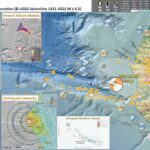I was returning from New Orleans where I was attending the American Geophysical Union Fall Meeting. There was a short layover in Denver and I had a short time to find some food, which is challenging with my dietary restrictions.…
Tsunami Report: Hunga Tonga-Hunga Ha’apai Volcanic Eruption & Tsunami
I will be filling this in over the next few days and wanted to start collating social media materials for this event. There was a large volcanic eruption in the Tonga region. This eruption was observable from satellites and has…

